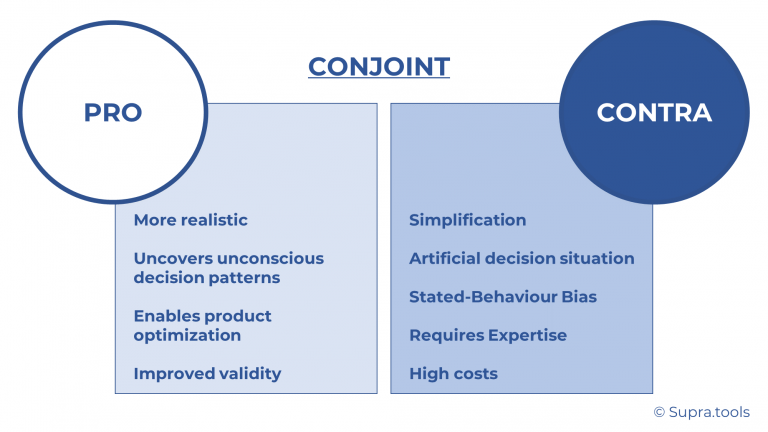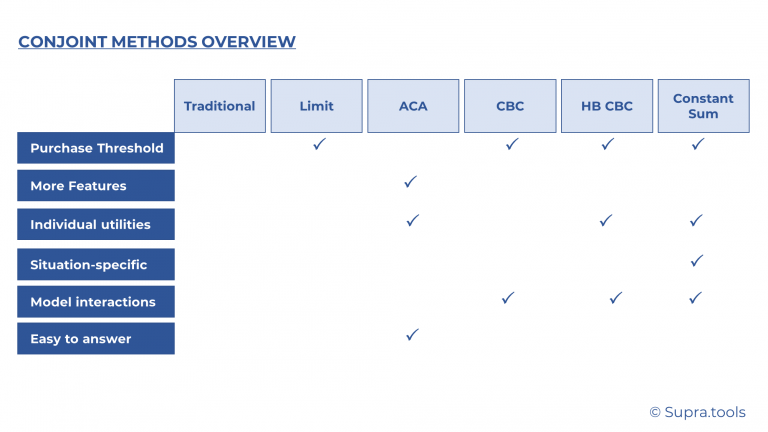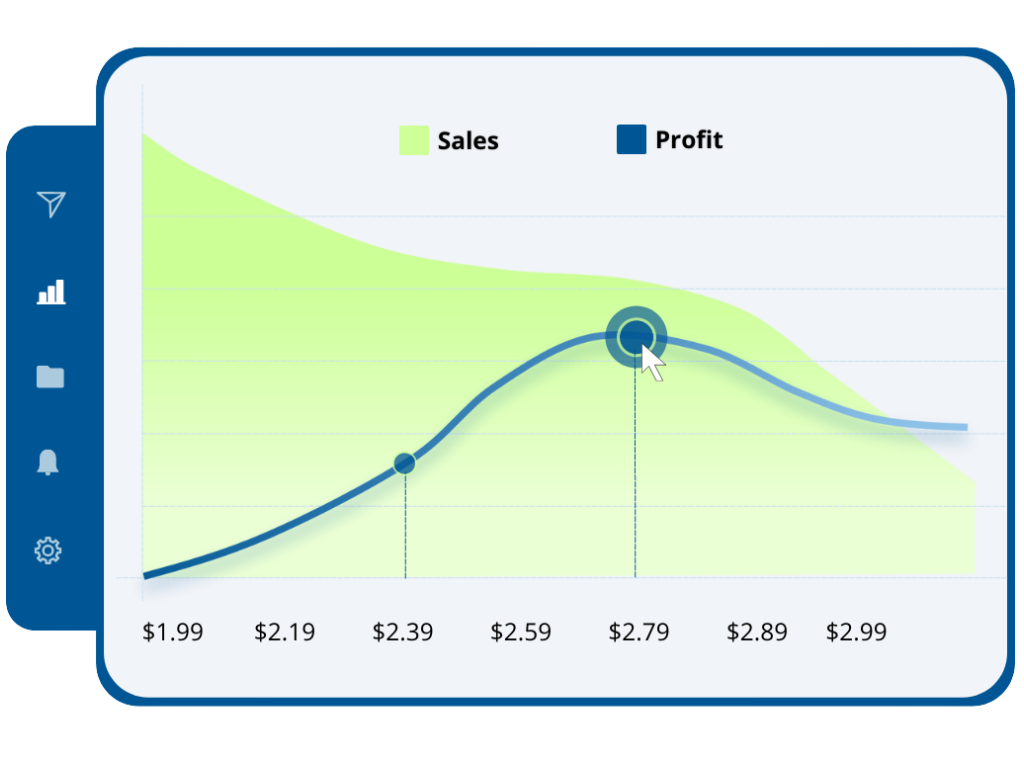May 12, 2022
Conjoint surveys for pricing consumer goods: Why, when, and which conjoint analysis makes sense.


My goal: You will understand when conjoint analysis can be useful, which methodology to choose and when it is better to switch to alternatives.
In the history of pricing, there have always been two approaches. The first is to observe prices in the market, relating them to the resulting sales. Part of this is price experiments in the market.
The second approach is to survey. Marketers have always asked themselves and their potential customers, “What would you be willing to pay?”
In addition to this qualitative approach, there are quantitative methods by trying to get a “feel for the market” in open-ended conversations.
The Garbor-Granger methods and the Van Westendorp Price Sensitivity Meter are the best-known direct survey methods.

They are simple and inexpensive to conduct. But their validity is compromised by various bias effects.
– Interest bias: As part of the target group, respondents have different interests than you as a company. The unspoken interest is to get a good product at a low price or enable other consumers to get one. Mostly these interests are unconscious. Nevertheless – or precisely because of this – they significantly control our thinking.
– Limited self-insight: The purchase decision has unconscious facets. The importance of the brand is central evidence. Given the objectively equal quality, many consumers nevertheless prefer certain brands and develop a willingness to pay for the imprinted brand symbol. Much of this is unconscious, and when it becomes conscious, consumers find justifications that make their behavior seem rational.
– Lack of realism: The experiment has the greatest realism. Asking consumers “what would you be willing to pay” requires them to simulate a realistic experiment mentally. An assumption that usually does not work out.
Conjoint analysis tries to solve the problems of classical survey methods.
The bestselling book „Pricing Intelligence“ has more on the topic and
Conjoint analysis was developed in the 1970s and has been continuously refined since then. It improves on the validity problems of classic methods by being
In many studies, it could be shown that conjoint often delivers more valid results than a direct price query. Nevertheless, selecting the appropriate methods and their parameterization is very important.

DELL was one of the first companies to use the benefits of Conjoint. The analysis was carried out in five steps.
Among the available methods, Dell chose a type of conjoint where the respondent is asked to make a (hypothetical) purchase decision (choice-based). In addition, the method was set so that one decision option is the “NONE” option, where the respondent does not make a decision.

The second step is to determine the most important product features. These include the price and the brand. Furthermore, in the PC area, it is the processor speed as well as the memory space. For most products, the list of features could theoretically be extended to infinity. However, conjoint requires a focus on a few important features. For one thing, the choice decision would otherwise take too long, and the respondents would tend to answer indiscriminately. Furthermore, the need for a larger sample increases with each feature.
Thirdly, all possible variants are defined for each feature. The competitor HP, Sony, and a NoName variant were defined as brands. As storage space, different characteristics of RAM and hard disk sizes were defined. For pricing, it is now essential to define the right price points. The price points should be equally spaced. The price range should be larger than is actually considered reasonable. Price thresholds (99er prices) should be chosen as common retail practices.
For the conjoint survey, the number of respondents and the number of choice tasks per respondent must be defined. At DELL, 200 respondents with 10 choice tasks were sufficient.
In the choice task, different product sets are presented. No respondent sees exactly the same sets. The variation of the level expressions is done according to certain methods, which differ per conjoint.

There are two types
– Random design: The features are randomly selected, and with a sufficiently large sample, it can be assumed that all relevant constellations are played through. The random design is not very efficient (you need more samples), but it is possible to model arbitrary feature interactions.
– Orthogonal design: With this design, the utility values can be calculated with the smallest number of tasks. For each product set, there is another product set that differs in only one level (it is “orthogonal” to the original).
DELL applied the random design, which is the common method for choice-based analysis.
The result of the conjoint analysis is so-called “utility values,” which are calculated for each characteristic of each feature. Positive utility values increase the willingness to buy, and negative ones decrease it.
From this alone, it is not yet possible to conclude how successful a product will be, nor what sales certain prices promise.
For this, a so-called market simulation must be created afterward.
For this purpose, Dell compiled the competition products with the help of the features and their market prices. The benefit values of all features can be added up for each product, resulting in a total benefit. The simulation assumes that the market share will be analogous to this total benefit and in relation to the benefit values of the competition.
By running through all the price levels, DELL now generated a price-sales function. A market share matched each price level for its own product.

If you multiply the market share (or the number of units) by the price, you get the turnover.
From this revenue, you subtract the cost of goods sold and the retail margin to get the price-profit function which visually shows the optimum.
For DELL, it became clear that their brand was very weak in comparison and had to be expanded. The optimization resulted in a very low price, which led to the brand growing quickly and profitably and building a brand willing to pay more over the years.
Some professionals prefer to access video tutorials around pricing and insights

Conjoint is not conjoint. There are dozens of variations and varieties. Here are the main basic types and their advantages and disadvantages.
Classic Conjoint
In the original variant, the respondent is shown a certain number of product alternatives to choose from with a request to sort them into a ranking order. This is then repeated several times
Two aspects, in particular, are described as disadvantageous:
Limit Conjoint
One problem of rank-based conjoint analysis is that it is not known at which utility value a purchase decision actually arises.
Limit conjoint asks the respondent in the rank order to set the so-called “limit card” and thus define from which rank order position a product can be considered for a purchase.
Adaptive Conjoint Analysis
This method simplifies the classic conjoint in that only two products are compared. A ranking is thus equal to a preference. Furthermore, only a limited number of features are displayed. ADAPTIVE the features are selected for which the procedure needs more information.
As a result, the process is significantly easier for respondents. Significantly more features can also be evaluated.
In addition, the methodology provides utility values for each respondent. This is useful if you want to do a market segmentation based on preferences afterward.

Choice-based Conjoint Analysis
In this type of conjoint analysis, the respondent is asked to make a (hypothetical) purchase decision. As a rule, only three to a maximum of five alternative products can be presented, which usually does not correspond to the real shelf situation. It is important to include a “None” option in this case. Only in this way can the algorithm recognize which features and prices increase the preference and the propensity to buy.
Hierarchical-Bayes Choice-based Conjoint Analysis
For mathematical reasons, Choice-based Conjoint only provides utility values for the entire market, but not for each respondent. “Hierarchical Bayes” is a statistical analysis extension where the method calculates utility values for each respondent. This allows market segmentation to be performed.
This is made possible by Hierarchical Bayes “borrowing” information from similar respondents. Therefore, the method is an approximation method whose accuracy is difficult to validate in detail.
Constant-Sum Choice-based Conjoint Analysis
People occasionally make decisions based on situations. Doctors prescribe different drugs not solely based on their characteristics but the patient’s characteristics in question. Nevertheless, consumers who are fundamentally opposed to soft drinks choose them a few times a year. Coca-Cola sells 50% of its total sales to consumers who do not drink soft drinks.
Constant-Sum Conjoint analysis can take this fact into account. For each product, the respondent indicates how many times out of 100 choices the decision would fall on this product.

Conjoint analysis measurements simulate a purchase decision situation in a conjoint survey. They then use multivariate statistics to determine the influence of product features and price levels on sales.
This makes them more realistic than direct methods, especially because they always relate the price directly to the benefit attributes.
In addition, conjoint methods are suitable for uncovering unconscious decision patterns. The preference or choice decisions in conjoint queries are so cognitively demanding that respondents tend to use decision heuristics similar to those in reality.
The cognitively overwhelming trade-off is the mechanism that helps uncover irrational aspects.
Despite the significant progress, there are some reasons to resort to alternatives in some circumstances. Here are the most important:
Simplification
Products are reduced to a few keywords for features and their characteristics, the number of which is also severely limited.
Artificial decision situation
Real decision situations can differ significantly from those in the experiment in individual cases. Consumers tend to consider only certain brands and often proceed in stages and by exclusion, only deciding between two or three alternatives (if at all).
The gap between word and action (Stated Behavior Bias)
Despite being closer to reality, respondents lack “skin in the game.” For example, a green power product resulted in a projected market share of 65%. Even 5 years later, only 5% was realized.
Expertise needed
Selection and configuration need experience and expertise.
High costs
Because an expert must be consulted, conjoint analyses should usually be conducted with a market research agency. This leads to high costs, long project duration, and low scalability of the method.

Methods of “Implicit Intelligence™” can be a viable alternative. Similar to Conjoint, they represent realistic query situations and can measure unconscious decision patterns.

Today pioneers use the latest pricing survey tools that use Neuroscience + AI
Interested professionals can use some tools even for free and explore on its own
You can access supra tools free here.
What do you mean by conjoint analysis, explain it with a suitable example?
Conjoint analysis is a statistical technique used to determine how people value different attributes of products or services. It involves presenting respondents with different combinations of features and asking them to choose which they prefer. The survey data from these choices can then be analyzed to reveal people’s importance of each feature.
An example of this would be if you wanted to know how people felt about different types of ice cream. You could give them a list of different flavors and ask them to choose the ones they like best.

Another example could be, if you were looking at different types of cars, you could ask people which features are most important to them. This would help you understand what people value in a car.
What is a conjoint experiment?
A conjoint analysis experiment is a type of market research used to determine how people value different features of products or services. A conjoint experiment is typically used when a company is trying to decide which features to include in a new product or service or when a company is trying to determine how to price it. In a conjoint experiment, people are shown different product or service variations, and they are asked to choose which one they prefer. The variations can include different combinations of features or prices for the same products or services.
How is the conjoint analysis used?
There are many ways that conjoint analysis can be used, but it is most commonly used in market research to help companies understand what features of their products or services are most important to consumers. It can also be used in product development to help identify new features that would be most appealing to customers.

What are the benefits of conjoint analysis?
There are several benefits of conjoint, including that it:
-Allows for the quantification of customer preferences
-Is relatively easy to implement
-Is highly flexible and can be customized to fit the needs of any project
-Provides accurate and actionable survey data that can be used to make informed decisions
Are there any drawbacks to conjoint analysis?
Like any statistical technique, there are some potential drawbacks to conjoint analysis, including:
-It can be time-consuming and resource-intensive to gather the data needed for the analysis
-It can be difficult to interpret the results of the analysis
-It is important to have a good understanding of statistics in order to use and interpret the results of conjoint analysis experiments properly.

What is conducted in a conjoint study?
Conducting a conjoint analysis employs trade-offs between different product attributes to understand how consumers value those attributes. This can help make decisions about product design, pricing, and marketing.
How does conjoint analysis work?
Conjoint analysis works by asking people to make trade-offs between different products or services, each with different combinations of attributes. For example, if you were considering launching a new mobile phone, you might ask people which of two phones they would prefer:

By observing which phone people choose in different scenarios, you can understand the relative importance of each attribute (e.g., 4G vs. 3G, high-resolution camera vs. low-resolution camera, large screen vs. small screen). 3. What are the benefits of conjoint analysis? There are many benefits of the conjoint study, including providing insights into customer preferences that can be used to improve product design or positioning. It can be used to assess the relative importance of different product attributes. It can be used to simulate different pricing scenarios. It can be used to segment customers based on their preferences. It can be used to understand how customers trade-off different product attributes.
How does a conjoint analysis survey work?
A conjoint analysis survey is a type of market research used to measure consumer preferences. It works by presenting survey respondents with a series of choices between different products, services, or features and asking them to choose the one they prefer. The survey results are then used to understand how consumers value the different attributes of the products or services being surveyed.
Conjoint analysis process: simplification strategies
There are a few different ways to simplify the process of conjoint analysis, and each has its advantages and disadvantages. One common simplification strategy is to reduce the number of levels for each attribute. This can be done by choosing only the most important levels for each attribute or combining similar levels. Another simplification strategy is to reduce the number of attributes considered in the analysis. This can be done by choosing only the most important attributes or eliminating attributes that are not essential to the analysis. Which simplification strategy best depends on the specific situation and the goals of the analysis. In general, it is best to use the simplest method that will still allow you to answer your research question accurately.
What are the key ingredients of pricing research?
Pricing research typically involves studying customer behavior in order to understand how they value different products and services. This information can then be used to help set prices that maximize profits while still appealing to customers. Therefore, key ingredients in pricing research include understanding customer needs and preferences and analytical tools to evaluate data.
What is conjoint analysis in marketing research?
Conjoint analysis is a market research technique that involves combining multiple measures of consumer preference into a single score. It can be used to understand how consumers value different combinations of attributes in products or services.
What are the various types of conjoint analysis techniques?
There are several different types of conjoint analysis; some of the common types are:
What are the steps involved in conjoint analysis?
Step 1. The first step in the conjoint analysis is to define the problem. What are you trying to learn? What are your objectives? What decision do you need to make?
Step 2. The second step in the conjoint analysis is to develop a questionnaire that measures consumer preferences for different combinations of product attributes. The questionnaire typically includes a series of trade-offs, where survey respondents are asked to choose between two or more products that differ in one or more attributes.
Step 3. The third step is to analyze the data from the questionnaire to understand how different combinations of attributes affect consumer preference. This analysis can identify the most important product attributes and understand how consumers value different combinations of attributes.

Is conjoint a multivariate analysis?
Yes, conjoint is multivariate analysis. It is a type of multivariate analysis that specifically considers how people make choices between different options.
What is the conjoint study used for?
Conjoint is used for market research. It is a tool that helps market researchers understand how consumers make choices by assessing their preferences for different combinations of products or services.
What is the difference between conjoint and discrete choice?
The key difference between discrete choice and conjoint models is that discrete choice models focus on making accurate predictions about market behavior, while conjoint models do not. Conjoint models instead use product profiles to estimate underlying utilities.

Discrete choice conjoint analysis are based on the assumption that consumers make choices by considering a set of alternatives and selecting the one that offers the most utility. In contrast, conjoint models estimate utilities for each product or service attribute independently and then combine them to arrive at an overall utility for the product or service.
How does conjoint analysis help the marketing professionals illustrate with suitable examples?
Conjoint analysis is a market research technique that helps professionals understand how people make choices. By analyzing how people choose between different options, marketers can better understand what products and services people are likely to want. This information can help businesses create more effective marketing campaigns and product offerings.
For example, if you’re selling ice cream, you might want to know how much people are willing to pay for different flavors, sizes, and toppings. Conjoint analysis can help you understand these preferences and make better decisions about your product mix.
What is Conjoint and MaxDiff?
Conjoint analysis and MaxDiff are powerful market research techniques that help companies understand consumer preferences. However, there are some key differences between these two methods.
Conjoint analysis is a market research technique that helps companies understand how consumers make trade-offs between competing products. Conjoint analysis can measure the relative importance of different product attributes and estimate the demand for new product ideas.

MaxDiff is a market research technique that helps companies understand how consumers compare and rank competing products. MaxDiff can identify the most and least important product attributes and estimate the demand for new product ideas.
Can SurveyMonkey conduct conjoint analysis?
Yes, SurveyMonkey can do the conjoint analysis. SurveyMonkey is not just a simple survey tool. It is a powerful marketing research tool that can help you understand what features matter most to your customers. And one of the most powerful techniques it offers is conjoint analysis.
How do you write a conjoint analysis questionnaire?
There are many ways to write a conjoint analysis questionnaire, but a common way is to list the attributes of the product or service you are trying to measure in order of importance. For each attribute, ask respondents how important it is to them on a scale from 1 to 10. Then, use those scores to create an index number for that attribute.
What is the common conjoint analysis software?
The common conjoint analysis software is SPSS or Sawtooth. However, it is not the only software on the market. There are other options like Conjoint.ly, Quantilope, and many more that may better fit your needs.
How do you interpret conjoint data?
Conjoint data can be interpreted in many ways, depending on the research question being asked.
A few different methods can be used to analyze conjoint surveys, but the most common is called full-profile conjoint analysis. The full-profile analysis involves creating a regression model that includes all of the attributes and levels being studied. This approach makes it possible to estimate how much each attribute contributes to the overall preference for a product.
What does Part-worth mean?
In conjoint analysis, part-worths are the level utilities for conjoint attributes. The part-worth of each attribute contributes to a total product concept worth that is calculated by adding together the combined value of all its features, which sum to the complete product concept’s combined value.
When constructing conjoint analysis stimuli, is it necessary to evaluate all possible combinations of levels of the attributes?
No, it is not necessary to evaluate all possible combinations of levels of the attributes. Evaluating all possible combinations of levels of the attributes can be time-consuming and costly. Instead, it is typically sufficient to evaluate a subset of the possible combinations of levels of the attributes. The number of possible combinations of levels of the attributes that should be evaluated depends on the specific situation and the available resources.
How can conjoint analysis be improved?
There are a few ways that conjoint analysis can be improved.
In my email newsletter “Pricing Insights” I cover the whole range of pricing insights solutions-from Garbor Granger to Conjoint, from NeuroPricing to Pricing Software Systems. I describe the application in various fields from new product pricing to promotion, from brand premium to feature pricing.
Keep up to date here.